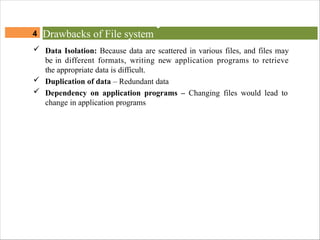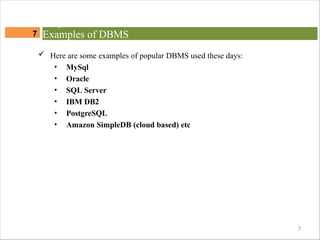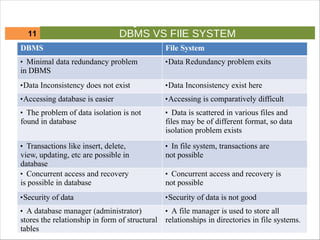unit 1 introduction to dbms [1-1.2].pptx
- 1. Block 1:The Database Management Concepts Unit 1: Basic Concepts[1-1.2] By AaliyaMalek
- 2. Chapter Contents ’ü▒ Data & Information ’ü▒ Drawbacks of File system ’ü▒ What is Database Management Systems ? ’ü▒ What is the need of DBMS? ’ü▒ Examples of DBMS ’ü▒ Database Types ’ü▒ Applications of DBMS ’ü▒ Advantage of DBMS over file system ’ü▒ Disadvantages of DBMS ’ü▒ DBMS vs. File System 2 Concepts
- 3. ’ā╝ Data can be defined as a representation of facts, concepts, or instructions in a formalized manner, which should be suitable for communication, interpretation, or processing by human or electronic machine. ’ā╝ Generally data is raw and unprocessed. ’ā╝ Data becomes information when it is processed, turning it into something meaningful. ’ā╝ Information is organized or classified data, which has some meaningful values for the receiver. Information is the processed data on which decisions and actions are based. 3 Data & Information Data & Information
- 4. ’ā╝ Data Isolation: Because data are scattered in various files, and files may be in different formats, writing new application programs to retrieve the appropriate data is difficult. ’ā╝ Duplication of data ŌĆō Redundant data ’ā╝ Dependency on application programs ŌĆō Changing files would lead to change in application programs 4 Drawbacks of File system Drawbacks of File system
- 5. ’ā╝ DBMS stands for Database Management System. We can break it like this DBMS = Database + Management System. ’ā╝ Database is a collection of data and Management System is a set of programs to store and retrieve those data. Based on this we can define DBMS like this: DBMS is a collection of inter-related data and set of programs to store & access those data in an easy and effective manner. ’ā╝ For example: The college Database organizes the data about the admin, staff, students and faculty etc. 5 5 What is Database Management Systems ? What is Database Management Systems ?
- 6. ’ā╝ Database systems are basically developed for large amount of data. When dealing with huge amount of data, there are two things that require optimization: Storage of data and retrieval of data. ’é¦ Storage: According to the principles of database systems, the data is stored in such a way that it acquires lot less space as the redundant data (duplicate data) has been removed before storage. . ’é¦ Fast Retrieval of data: Along with storing the data in an optimized and systematic manner, it is also important that we retrieve the data quickly when needed. Database systems ensure that the data is retrieved as quickly as possible. 6 6 What is the need of DBMS? What is the need of DBMS ?
- 7. ’ā╝ Here are some examples of popular DBMS used these days: ŌĆó MySql ŌĆó Oracle ŌĆó SQL Server ŌĆó IBM DB2 ŌĆó PostgreSQL ŌĆó Amazon SimpleDB (cloud based) etc 7 7 Examples of DBMS Examples of DBMS
- 8. ’ü▒ Depending on the number of users accessing the database, a database system may be classified as ’āś Single-user database system: It supports only one user at a time. When a single- user database runs on a personal computer, it is also called a desktop database system ’āś Multi-user database system: It supports multiple users at the same time. When a multi-user database supports relatively small number of users, it is called as a workgroup database system. If the database is used by many users across globe, it is known as enterprise database system ’ü▒ Depending on the location of the database, a database system may be classified as: ’āś Centralized database system: It supports data located at a single site or single place ’āś Distributed database system: It supports data distributed across several different sites. Here, the same database can be replicated and stored in another computer so that when ever the original server goes down; the data can be available to the user from the replicated data from other servers. 8 8 Database Types
- 9. ’ā╝ Airline Reservation system ’ā╝ Banking : for customer information, accounts and loans and banking transactions. ’ā╝ Universities : for student registrations and grades. ’ā╝ Airlines : for reservations and schedule information. ’ā╝ Library Management System : maintain all the information relate to book issue dates, name of the book, author and availability of the book. ’ā╝ Telecommunications : for keeping records of call made, generating monthly bills, maintaining balances on prepaid calling cards. ’ā╝ Sales : for customer, product and purchase information. ’ā╝ Finance : for storing information about holdings, sales, and purchases of financial instruments such as stocks and bonds. ’ā╝ Human Resource : for information about employees, salaries, payroll taxes and benefits ’ā╝ Manufacturing : for management of supply chain and for tracking production of items in factories, inventories of items and orders for items. ’ā╝ Medical Sector ’ā╝ Military 9 9 Applications of DBMS Applications of DBMS
- 10. processing 1 ’ā╝ Controlling of Redundancy : Data redundancy refers to the duplication of data (i.e. storing same data multiple times). In a database system, by having a centralized database and centralized control of data by the DBA the unnecessary duplication of data is avoided. It also eliminates the extra time for processing the large volume of data. It results in saving the storage space ’ā╝ Improved Data Sharing : DBMS allows a user to share the data in any number of application programs ’ā╝ Data Integrity : Integrity means that the data in the database is accurate. Centralized control of the data helps in permitting the administrator to define integrity constraints to the data in the database. For example: in customer database we can can enforce an integrity that it must accept the customer only from Noida and Meerut city. ’ā╝ Security : Having complete authority over the operational data, enables the DBA in ensuring that the only mean of access to the database is through proper channels. The DBA can define authorization checks to be carried out whenever access to sensitive data is attempted. ’ā╝ Efficient Data Access : In a database system, the data is managed by the DBMS and all access to the data is through the DBMS providing a key to effective data 0 10 Advantage of DBMS over file system Advantage of DBMS over file system
- 11. DBMS File System ŌĆó Minimal data redundancy problem in DBMS ŌĆóData Redundancy problem exits ŌĆóData Inconsistency does not exist ŌĆóData Inconsistency exist here ŌĆóAccessing database is easier ŌĆóAccessing is comparatively difficult ŌĆó The problem of data isolation is not found in database ŌĆó Data is scattered in various files and files may be of different format, so data isolation problem exists ŌĆó Transactions like insert, delete, view, updating, etc are possible in database ŌĆó In file system, transactions are not possible ŌĆó Concurrent access and recovery is possible in database ŌĆó Concurrent access and recovery is not possible ŌĆóSecurity of data ŌĆóSecurity of data is not good ŌĆó A database manager (administrator) stores the relationship in form of structural tables ŌĆó A file manager is used to store all relationships in directories in file systems. 11 DBMS VS FIlE SYSTEM DBMS vs. File System
- 13. Thank you
![Block 1:The Database Management
Concepts
Unit 1: Basic
Concepts[1-1.2]
By AaliyaMalek](https://image.slidesharecdn.com/unit11-1-240826101701-c858199a/85/unit-1-introduction-to-dbms-1-1-2-pptx-1-320.jpg)











